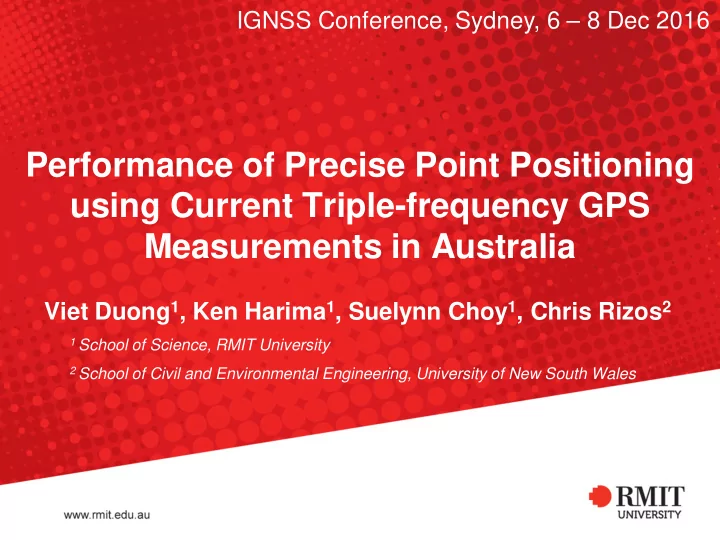

IGNSS Conference, Sydney, 6 – 8 Dec 2016 Performance of Precise Point Positioning using Current Triple-frequency GPS Measurements in Australia Viet Duong 1 , Ken Harima 1 , Suelynn Choy 1 , Chris Rizos 2 1 School of Science, RMIT University 2 School of Civil and Environmental Engineering, University of New South Wales
Outline ❶ Introduction to triple-frequency PPP ❷ Aims of research ❸ Mathematical models ❹ Methodology ❺ Results & Conclusion Viet Duong | RMIT University 2
Introduction to Triple-frequency PPP • NRTK is not suited for precise positioning service on a wide-area or global scale • PPP requires a long convergence time (e.g. several tens of minutes), not suitable for real-time applications • Using triple-frequency GPS can speed up convergence time as shown by Laurichesse (2012, 2015, 2016) • The data used is limited due to the limited number of GPS Block IIF satellites and ground infrastructure limitations Viet Duong | RMIT University 3
Aims at research • To provide an insight into the current performance of triple-frequency GPS PPP in Australia Number of triple-frequency GNSS satellites in view for a given location Source: reproduced from Laurichesse (2016) Viet Duong | RMIT University 4
Mathematical models • Single-differenced-between-satellite method has been used • Three main steps for dealing with triple- frequency PPP: Viet Duong | RMIT University 5
Mathematical models Wavelengths Noise levels of Parameters Possible advantages (m) combinations Steps for Triple-frequency Dual Triple Dual Triple Dual Triple Not Not N EWL Ambiguities are FIXED applied 0.7 σ P EWL 5.86 applie instantaneously d -WL ambiguities can be fixed U+ WL in about two minutes 0.7 σ P 110 σ L N WL 0.86 3.40 T+ -Providing decimetre-level N WL positioning accuracy -An optimal combination for phase measurements with a U+ U+ 0.107 0.108 2.99 σ P 110 σ L low noise level NL T+ T+ 2.99 σ L 2.54 σ L -Using the support of WL and N NL N NL EWL to create a new form “code measurement” U: user positions; T: troposphere delays; N: Ambiguities Viet Duong | RMIT University 6
Methodology – Static test • The research used real observations collected from eight Australian CORS stations over one week period in 2016 • Triple- and dual- frequency PPP results were compared for both float and fixed ambiguities • The proposed algorithms in Laurichesse (2012, 2015, 2016), Li et al. (2013), Geng and Bock (2013) have been implemented • A modified version of RTKLIB and Matlab-based GPS PPP data processing software have been developed. Viet Duong | RMIT University 7
Methodology – Static test 8 GNSS CORS stations from Visibility of the GPS Block IIF the Australian Regional GNSS satellites transmitting L5 signal at Network (Source: Google Earth) the ALIC station on DOY 215 2016 Viet Duong | RMIT University 8
Results • Float solution for dual- and triple- PPP approaches 0.5 RMS-Hz-Dual 0.4 RMS-Hz-Triple+Dual 0.3 Horizontal RMS(m) 0.2 0.1 0 0 10 20 30 40 50 60 70 80 90 0.5 10 cm: RMS-Up-Dual 2F&3F ~ 22 min 0.4 RMS-Up-Triple+Dual 0.3 Vertical RMS (m) 0.2 0.1 0 0 10 20 30 40 50 60 70 80 90 Time (minutes) Viet Duong | RMIT University 9
Results • Fixed solution for dual- and triple- PPP approaches 0.5 RMS-Hz-Dual 0.4 RMS-Hz-Triple+Dual 0.3 Horizontal RMS (m) 0.2 0.1 0 0 10 20 30 40 50 60 70 80 90 0.5 10 cm RMS-Up-Dual 3F : ~ 9 0.4 RMS-Up-Triple+Dual 2F : ~ 14min 0.3 Vertical RMS (m) 0.2 0.1 0 0 10 20 30 40 50 60 70 80 90 Time (minutes) Viet Duong | RMIT University 10
Results • Ambiguity fixing rate 100 SR-Dual SR-Triple+Dual 90 80 AFR > 95%, 70 after 20min 60 Ambiguity Fixing Rate (%) 50 40 30 20 10 0 0 10 20 30 40 50 60 70 80 90 Time (minutes) Viet Duong | RMIT University 11
Results • Positioning convergence time with combined results from eight selected stations Convergence time (minutes) Convergence time (minutes) Horizontal Vertical RMS RMS Dual Dual Triple Triple Dual Dual Triple Triple threshold threshold float fixed float fixed float fixed float fixed < 5cm N/A 22 N/A 17 < 5cm N/A 26 N/A 17 < 10cm 25 15 23 10 < 10cm 24 12 24 10 < 15cm 15 9 9 7 < 15cm 12 10 11 7 *N/A: Data collected is not enough to reach accuracy levels. Viet Duong | RMIT University 12
Conclusion • Dual- and triple- frequency PPP GPS performance in Australia has been demonstrated • Triple-frequency GPS satellites: – strengthen the PPP positioning model, – improve the float ambiguity positioning accuracy & shorten solution convergence time by an average of 5 minutes compared to dual-frequency PPP – Increase the ambiguity fixing success rate by 10% • Future work: Adding multi-constellation and multi-frequency GNSS to the PPP model, expanding with kinematic mode Viet Duong | RMIT University 13
Viet Duong | RMIT University 14
References • Laurichesse, D 2012, Phase Biases Estimation for Undifferenced Ambiguity Resolution, paper presented to PPP-RTK & Open Standards Symposium, Frankfurt, Germany. • Laurichesse, D 2015, Handling the Biases for Improved Triple-Frequency PPP Convergence, GPSWorld . • Laurichesse, D 2016, Fast PPP Convergence Using Multi-Constellations And Triple- Frequency Ambiguity Resolution, paper presented to IGS, Australia. • Li, T, Wang, J & Laurichesse, D 2013, Modeling and quality control for reliable precise point positioning integer ambiguity resolution with GNSS modernization, GPS Solutions , vol. 18, no. 3, pp. 429-42. • Geng, JH & Bock, Y 2013, Triple-frequency GPS precise point positioning with rapid ambiguity resolution, Journal of Geodesy , vol. 87, no. 5, pp. 449-60. • El-Mowafy, A, Deo, M & Rizos, C 2016, On biases in precise point positioning with multi-constellation and multi-frequency GNSS data, Measurement Science and Technology , vol. 27, no. 3, p. 035102. Viet Duong | RMIT University 15
Recommend
More recommend